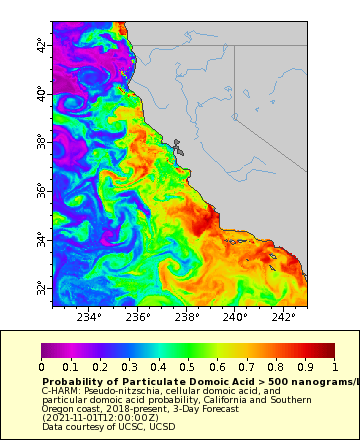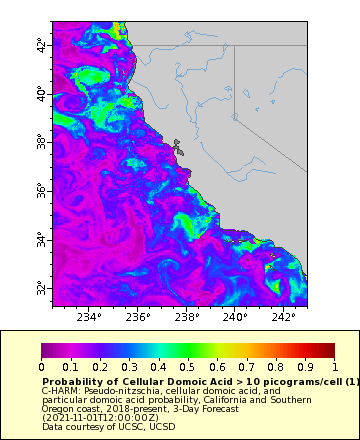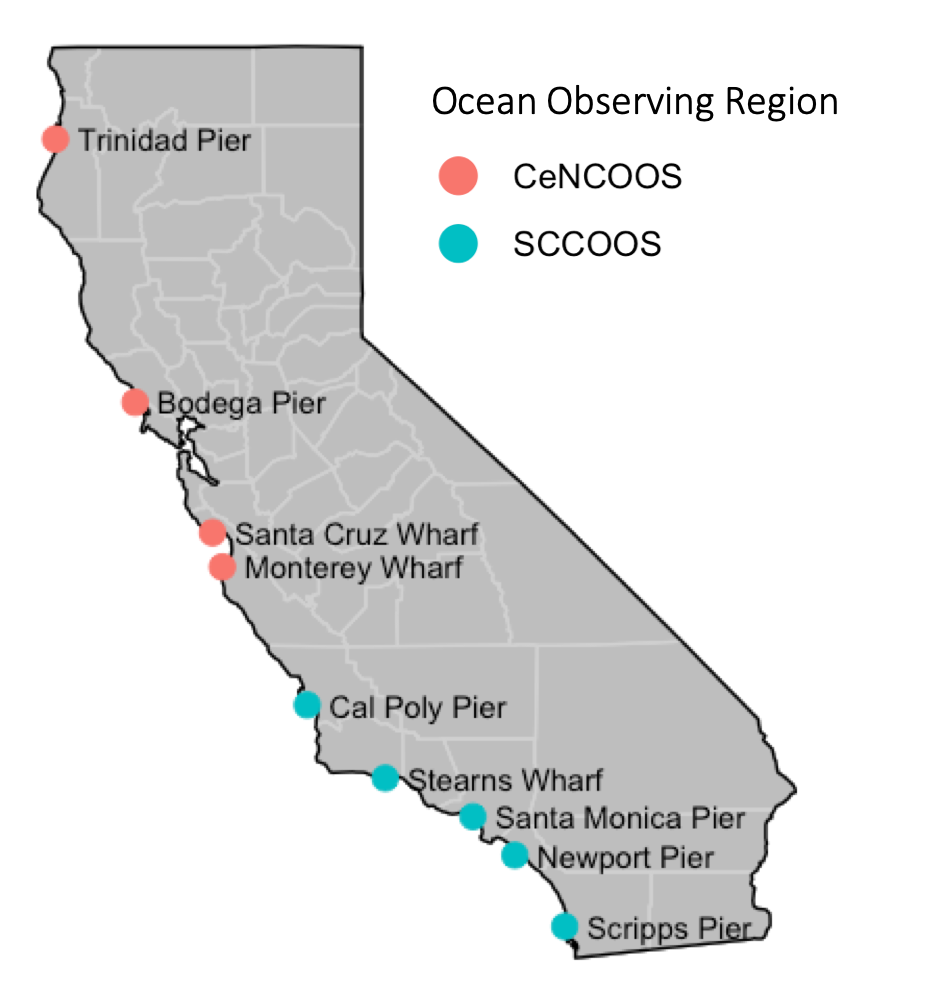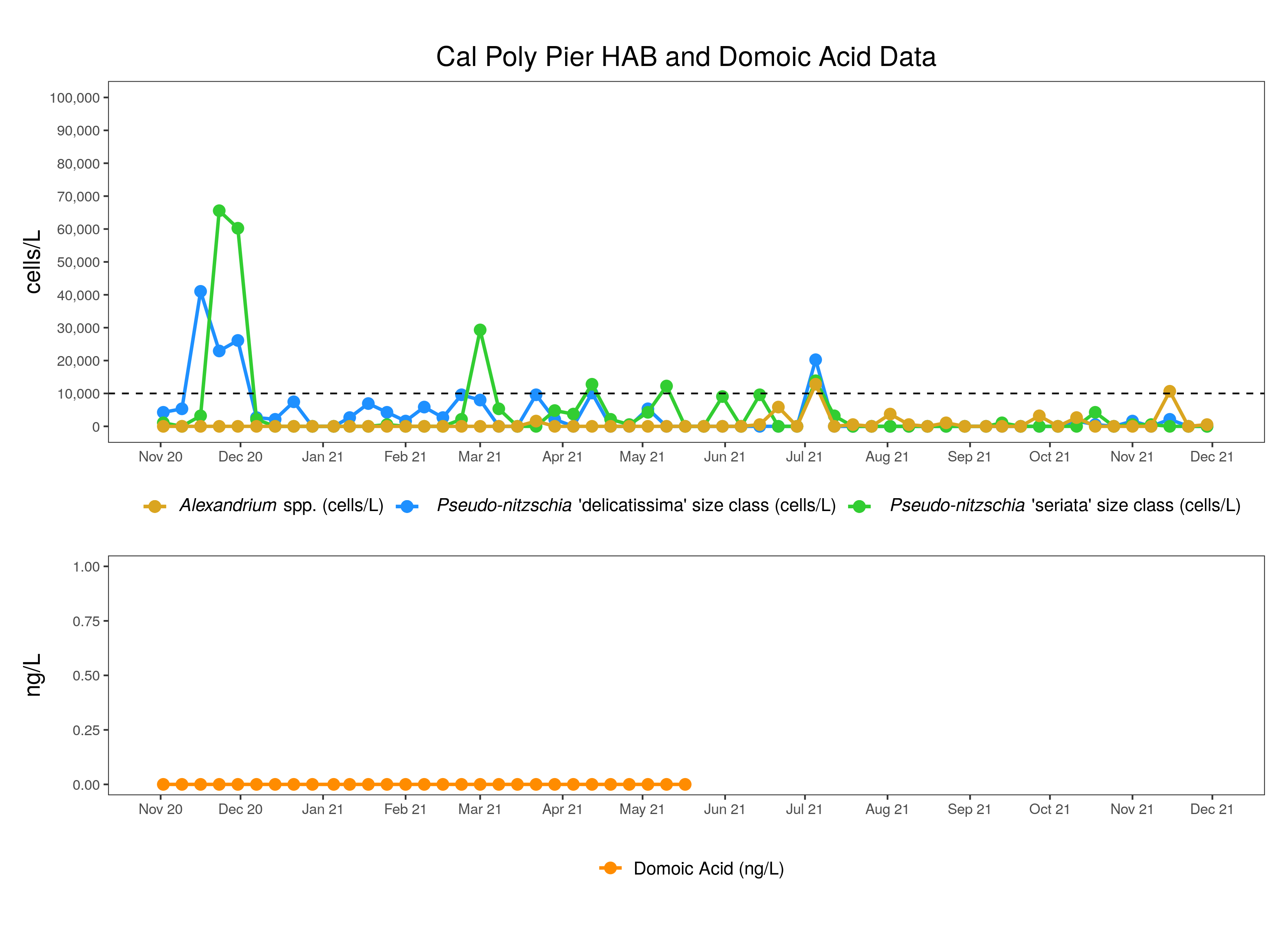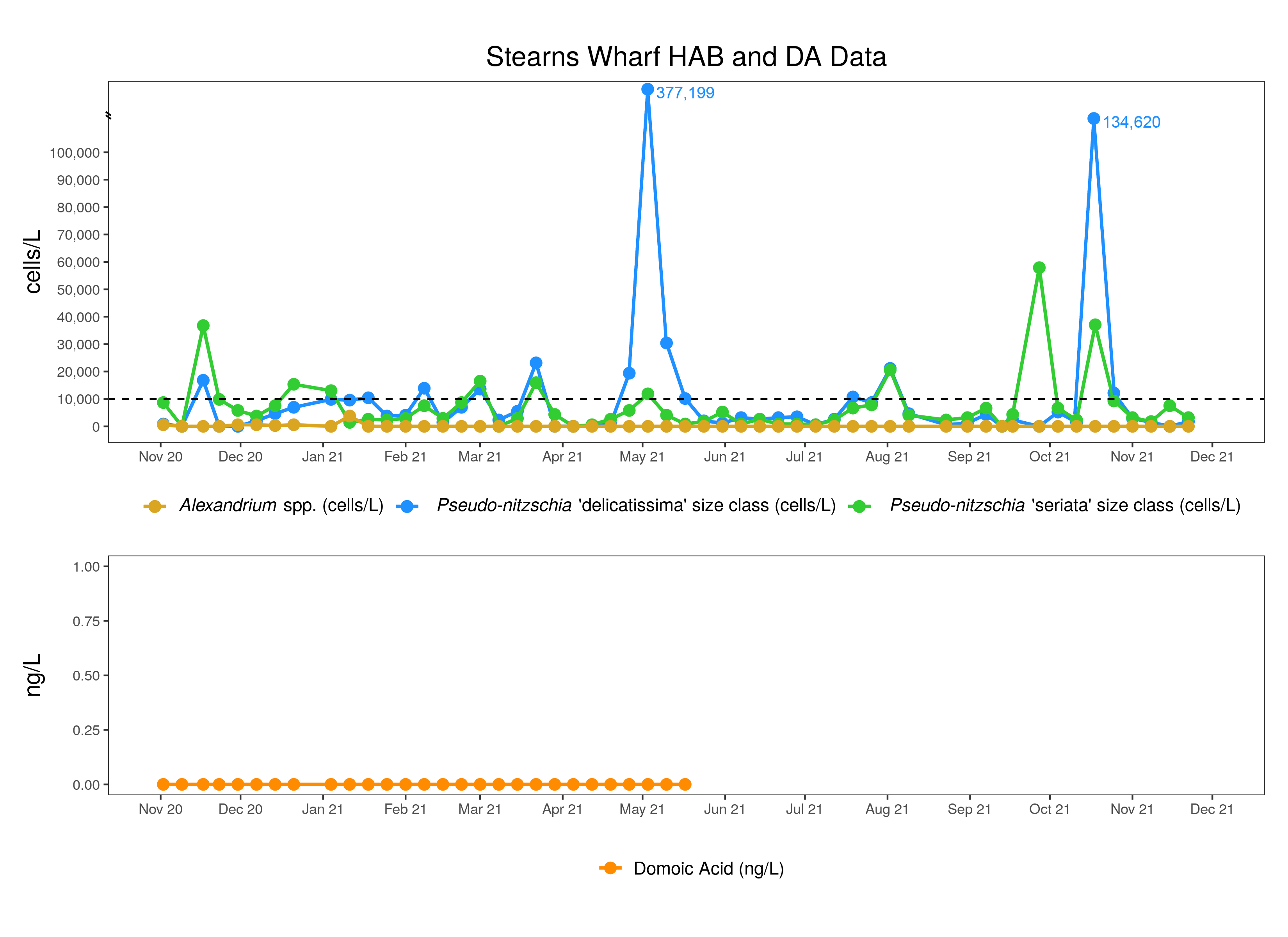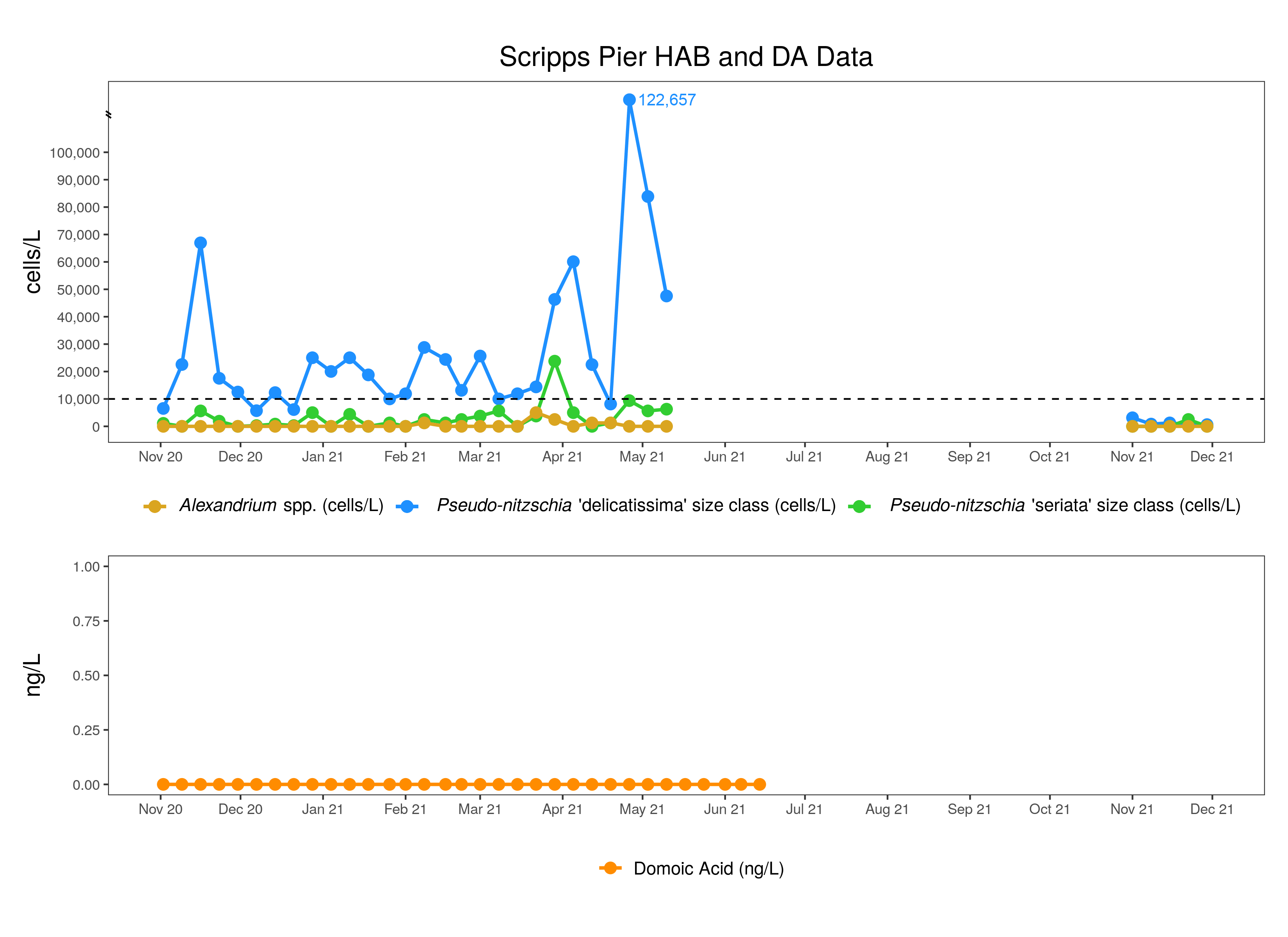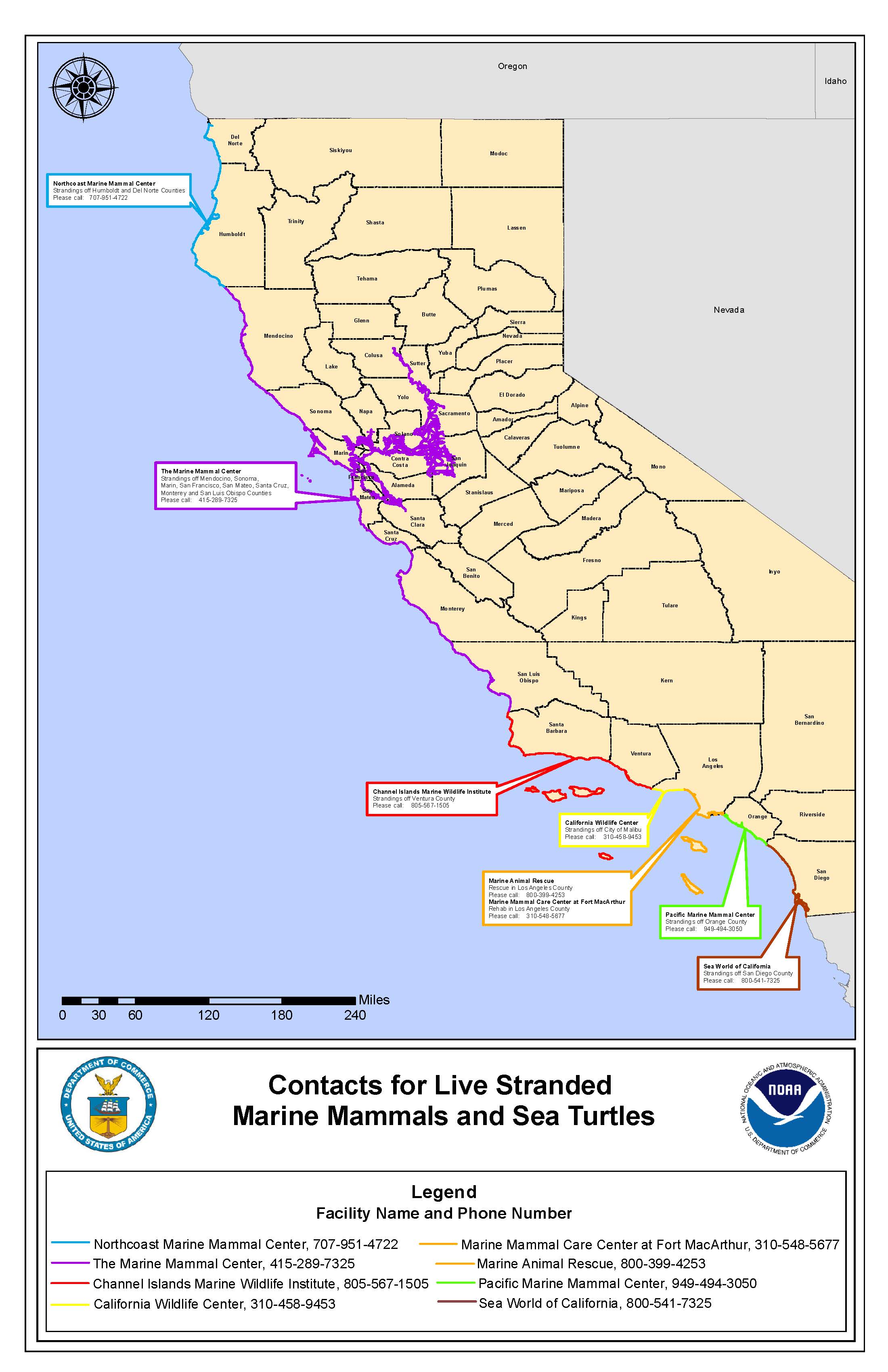NOVEMBER HIGHLIGHTS
Pseudo-nitzschia -
- C-HARM tells us where conditions are suitable for species of the diatom Pseudo-nitzschia spp. (all size classes) to grow well and where they might be more likely to produce the deadly neurotoxin, domoic acid (DA).
- C-HARM predictions in November were similar to October for Pseudo-nitzschia spp., suggesting widespread habitat suitability throughout the state, with very high bloom probabilities predicted for the entire coast out to many 100s of kilometers offshore.
- Unlike in October, Pseudo-nitzschia spp. were not detected, however, at bloom levels at any of the HABMAP pier sampling sites, despite one or both size classes being present at all sites at some point in November.
- Domoic acid data are reported for most of November at Santa Cruz Wharf, and all samples were below detection (i.e. no detectable DA), as they have been for at least a year. DA data for the other HABMAP pier sites were not yet available.
- Pseudo-nitzschia activity from CDPH sampling was similar to that of HABMAP, in that the toxigenic 'seriata' size class was "Present" at many sites distributed from La Jolla to Drakes and Tomales Bays, although it never reached "Common" RAI levels at any site sampled (10-49%) in November, indicating a reduction in Pseudo-nitzschia abundance at those sites similar to that seen at the HABMAP pier sites.
- The moderate to very high C-HARM probabilities (50-100%) for particulate domoic acid (pDA) that were predicted along the three major sections of coastline observed in October began to subside after the first week of November, leaving several smaller foci of high pDA probabilities for the rest of the month: southern California (with sporadically high probabilities in the Santa Barbara Channel); sporadic flare ups in Monterey Bay and outside SF Bay; and off Pt. Arena in northern California.
- Unlike in October, cellular domoic acid (cDA) predictions were not well pronounced in northern California and instead suggested milder conditions for cDA throughout the state, boding well for the crab domoic acid advisory issued for recreationally caught Dungeness crab viscera in Sonoma County on Nov. 5th, likely due to the suspected build-up of DA in sediments in September and October. Indeed, the Dungeness crab advisory was lifted on Nov 29th for Sonoma/Mendocino County Line to Point Reyes in Marin County.
- Only a singe marine mammal stranding was recorded from potential DA toxicosis in the month of November, and that occurred in Santa Cruz on Nov 12th and may be a result of the previous two weeks or more of feeding in the region, although note that C-HARM suggested hot spots throughout Monterey Bay at different points in November.
- Note the Nov 5th advisory for domoic acid and Dungeness crab, which was lifted Nov 25th for some counties.
Alexandrium -
- CDPH noted that Alexandrium spp. were "Present" at sites from San Diego Bay to Santa Cruz Wharf in November, although none were detected at HABMAP sites other than Santa Cruz Wharf. There are currently no advisories for Paralytic Shellfish Poisoning.
*Please note that HABMAP sampling, CDPH sampling, and marine mammal rescues have been greatly reduced in response to COVID-19 safety measures.
Summary written by Clarissa Anderson on January 12, 2022
**HABMAP sampling resumed after being suspended in March 2020 in accordance with the Governor's stay at home order. However, COVID-19 safety protocols and sampling restrictions may continue to affect operations and delay results.**
Note that data for some stations are not shown because they are not yet recorded in the public HABMAP archive.
Differentiating Pseudo-nitzschia species by light microscopy is difficult. For this reason, Pseudo-nitzschia "seriata" does not refer to an actual species but rather the larger size class of Pseudo-nitzschia, which is generally a more toxigenic group of species. Alternatively, Pseudo-nitzschia "delicatissima" refers to the smaller size class that is generally non-toxigenic. The dashed line on the plots demarcates the 10,000 cells/L "bloom" threshold designated here for Pseudo-nitzschia populations only.
More information and data visualizations on the statewide HAB network and forecasting system can be found on the California HABMAP website and on the SCCOOS Harmful Algal Bloom page.
Santa Cruz Wharf
Four water samples were collected at Santa Cruz Wharf in November. Molecular probes for toxigenic Pseudo-nitzschia in the "seriata" class are conducted for this site, and was detected once on November 24. Alexandrium spp. were detected on each occasion (November 3, 10, 17, 24). Domoic acid was not detected but 2 samples are still pending analysis.
The Santa Cruz Wharf shore station is supported by CeNCOOS PI Raphael Kudela at UCSC.
Cal Poly Pier
Five water samples were collected at Cal Poly Pier in November. Pseudo-nitzschia "delicatissima" was detected twice (November 1, 15) below the bloom threshold. Pseudo-nitzschia "seriata" was detected twice (November 1, 8), also below the bloom threshold. Alexandrium spp. were detected on November 15, 29. Domoic acid results are not yet available.
Cal Poly Pier shore station is supported by SCCOOS and PIs Ryan Walter and Ally Pasulka at Cal Poly.
Stearns Wharf
Four water samples were collected at Stearns Wharf in November. Pseudo-nitzschia "delicatissima" was detected on three occasions (November 1, 8, 22), all below the bloom threshold. Pseudo-nitzschia "seriata" was detected on each occasion (November 1, 8, 15, 22), also below the bloom threshold. Alexandrium spp. were not detected and domoic acid results are not yet available.
Stearns Wharf is supported by SCCOOS and PIs Mark Brzezinski and Libe Washburn at UCSB.
Santa Monica Pier
Five water samples were collected at Santa Monica Pier in November. Pseudo-nitzschia "delicatissima" was not detected. Pseudo-nitzschia "seriata" was detected once on November 29 below the threshold. Alexandrium spp. were not detected and domoic acid results are not yet available.
The Santa Monica Pier shore station is supported by SCCOOS and PI Rebecca Shipe at UCLA.
Newport Beach Pier
Four water samples were collected at Newport Beach Pier in November. Pseudo-nitzschia "delicatissima", Pseudo-nitzschia "seriata", and Alexandrium spp. were not detected. Domoic acid results are not yet available.
Newport Beach Pier is supported by SCCOOS and PI David Caron at USC.
Scripps Pier
Five water samples were collected at Scripps Pier in November. Pseudo-nitzschia "delicatissima" was detected on each occasion (November 1, 8, 15, 22, 29) below the bloom threshold. Pseudo-nitzschia "seriata" was detected once on November 22 below the threshold. Alexandrium spp. were not detected and domoic acid results are not yet available.
Scripps Pier is supported by SCCOOS and PIs Melissa Carter and Clarissa Anderson at UCSD.
CDPH observations for Pseudo-nitzschia "seriata" and Alexandrium spp.
You can view the interactive map and data table of California Department of Public Health (CDPH) data from January 2019 to present, developed by SCCOOS, below. Or, view CDPH Toxic Phytoplankton Observations Map with layers of Pseudo-nitzschia and Alexandrium spp. as well as other phytoplankton species observations (in the pop-up windows).
Data are provided by the Environmental Management Branch of the CDPH. Please note, starting in July 2019, CDPH moved to only reporting Pseudo-nitzschia of the seriata complex and not all Pseudo-nitzschia spp. as previously provided.
Please email CDPH at Susan.Paulukonis@cdph.ca.gov for any potential marine HAB-related illness in humans.
From November 1-30 2021, water samples were collected by volunteers and sent to the California Department of Public Health (CDPH) for analysis.
Pseudo-nitzschia "seriata" group was detected in 27 of the 76 samples:
Pseudo-nitzschia "seriata" was not detected at "Common" density level.
Pseudo-nitzschia "seriata" was detected at "Present" density levels on 6 occasions:
- 2021-11-02 8% S.B. nearshore, WQ #003
- 2021-11-09 3% Tomales Bay, Lease #M430-15
- 2021-11-15 1% La Jolla, Scripps Pier
- 2021-11-22 2% Tomales Bay, Lease #M430-15
- 2021-11-22 1% Drakes Bay, Chimney Rock LBS
- 2021-11-28 2% Pacifica Pier
Pseudo-nitzschia "seriata" was detected at "Rare" density levels on 21 occasions:
- 2021-11-01 0.5% Humboldt Bay, Indian Is. Ch.
- 2021-11-01 0.5% San Luis Obispo, Cal Poly Pier
- 2021-11-02 0.5% Pillar Point
- 2021-11-02 0.5% Goleta Pier
- 2021-11-02 0.5% Imperial Beach Pier
- 2021-11-05 0.5% Catalina Island, Avalon Bay
- 2021-11-07 0.5% Pacifica Pier
- 2021-11-07 0.5% Santa Rosa Is., Bechers Bay
- 2021-11-08 0.5% Bodega Harbor, USCG Dock
- 2021-11-08 0.5% Bolinas Lagoon
- 2021-11-08 0.5% San Simeon Pier
- 2021-11-08 0.5% Monterey Bay, Commercial Wharf
- 2021-11-09 0.5% Imperial Beach Pier
- 2021-11-14 0.5% Pacifica Pier
- 2021-11-16 0.5% Tomales Bay, Lease #M430-15
- 2021-11-17 0.5% Santa Cruz Wharf
- 2021-11-20 0.5% Pacifica Pier
- 2021-11-22 0.5% Mendocino, Noyo Harbor
- 2021-11-24 0.5% Imperial Beach Pier
- 2021-11-24 0.5% San Simeon Pier
- 2021-11-26 0.5% Santa Cruz Wharf
Alexandrium spp. were detected in 31 of the 76 samples:
Alexandrium spp. were not detected at "Common" density level.
Alexandrium spp. were detected at "Present" density levels on 6 occasions:
- 2021-11-01 1% San Diego Bay, U.S. Navy Pier
- 2021-11-01 1% Monterey Bay, Commercial Wharf
- 2021-11-09 1% Goleta Pier
- 2021-11-10 5% San Diego Bay, U.S. Navy Pier
- 2021-11-18 2% Port San Luis, Diablo Cove
- 2021-11-24 1% Santa Cruz Wharf
Alexandrium spp. were detected at "Rare" density levels on 25 occasions:
- 2021-11-01 0.5% San Luis Obispo, Cal Poly Pier
- 2021-11-02 0.5% Goleta Pier
- 2021-11-03 0.5% Monterey, Stillwater Cove
- 2021-11-03 0.5% Santa Cruz Wharf
- 2021-11-08 0.5% La Jolla, Scripps Pier
- 2021-11-08 0.5% Bodega Harbor, USCG Dock
- 2021-11-08 0.5% Bolinas Lagoon
- 2021-11-08 0.5% Monterey Bay, Commercial Wharf
- 2021-11-09 0.5% Tomales Bay, Lease #M430-15
- 2021-11-11 0.5% Santa Barbara Ch., Naples Pt
- 2021-11-14 0.5% San Francisco, Presidio Pier
- 2021-11-15 0.5% La Jolla, Scripps Pier
- 2021-11-16 0.5% Goleta Pier
- 2021-11-16 0.5% San Diego Bay, U.S. Navy Pier
- 2021-11-16 0.5% Tomales Bay, Lease #M430-15
- 2021-11-19 0.5% Santa Barbara Ch., Naples Pt
- 2021-11-19 0.5% Santa Barbara, Mohawk Reef
- 2021-11-20 0.5% Pacifica Pier
- 2021-11-22 0.5% Drakes Bay, Chimney Rock LBS
- 2021-11-22 0.5% Mendocino, Noyo Harbor
- 2021-11-22 0.5% Tomales Bay, Lease #M430-15
- 2021-11-24 0.5% Goleta Pier
- 2021-11-24 0.5% San Simeon Pier
- 2021-11-24 0.5% Imperial Beach Pier
- 2021-11-26 0.5% Santa Cruz Wharf
CDPH and OEHHA Health Advisories
December 16. The California Department of Public Health (CDPH) is advising consumers not to eat sport-harvested razor clams from Del Norte County due to dangerous levels of naturally occurring domoic acid, also referred to as Amnesic Shellfish Poisoning, being detected.
November 29. The California Department of Public Health (CDPH) has lifted the shellfish safety notification for Dungeness crab caught in state waters from the Sonoma/Mendocino County Line (38° 46.125' N. Latitude) to Point Reyes (38° N. Latitude) in Marin County.
November 5. Due to the detection of elevated levels of domoic acid, a naturally occurring toxin, the California Department of Public Health (CDPH) is warning consumers not to eat the viscera (internal organs) of Dungeness crab caught in coastal waters.
October 29. The California Department of Public Health (CDPH) announced that the statewide annual quarantine on mussels gathered by sport harvesters from California's ocean waters ends at midnight on Saturday, October 31, 2021, for all coastal counties.
For the latest closures and updates, please visit the CDPH Health Advisories page as a central location of information related to CDPH health advisories. Also available is a map showing the current CDPH Recreational Bivalve Shellfish Advisories (see below).
NEWS: The HAB-related illness workgroup has developed a new webpage for marine HAB-related illness tracking work (https://oehha.ca.gov/fish/general-info/marine-harmful-algal-bloom-hab-related-illness-tracking).
Domoic acid (DA) is a potent neurotoxin produced by some diatom species of the genus Pseudo-nitzschia. Species exposed to DA can result in seizures, epilepsy, cardiomyopathy, and death depending upon the ingested dose. DA toxicosis commonly occurs in California Sea Lions (Zalophus californianus), presumably due to a combination of foraging behavior and seasonal movements. The Marine Mammal Center (TMMC), Channel Islands Marine Wildlife Institute (CIMWI), California Wildlife Center (CWC), Marine Mammal Care Center Los Angeles (MMCC-LA), Marine Animal Rescue (MAR), the Pacific Marine Mammal Center (PMMC), and SeaWorld act like an emergency room by working to rescue and rehabilitate sick and injured marine mammals, seabirds, and sea turtles.
The MMCCLA, PMMC, CIMWI SeaWorld, MAR, did not record any strandings due to suspected domoic acid in November 2021.
November strandings due to suspected DA toxicosis occurred in the following counties:
-
- Santa Cruz (TMMC)
- November 12 - adult, female, California Sea Lion
- Santa Cruz (TMMC)
At this time we do not have data from the North Coast Marine Mammal Center.
Please subscribe to CA HAB Bulletin listserv to receive the monthly CA HAB Bulletin.


